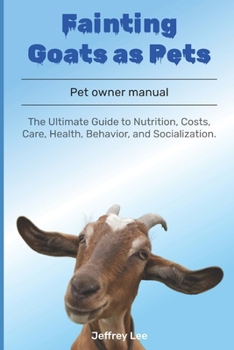Fainting Goats as Pets: The Ultimate Guide to Nutrition, Costs, Care, Health, Behavior, and Socialization.
The history of fainting goats can be traced back to the late 19th century in Tennessee, USA. According to historical accounts, a mysterious man named John Tinsley arrived in Marshall County, Tennessee, in the 1880s, bringing with him four goats that exhibited an unusual tendency to stiffen and fall when startled. The exact origin of these goats remains unclear, as Tinsley left Tennessee after a few years without revealing their ancestry.
Local farmers found these goats intriguing and began breeding them, recognizing their hardy nature, calm temperament, and high muscle density. Unlike traditional dairy or fiber goats, fainting goats were initially valued for their meat due to their well-muscled bodies. Over time, their unique genetic condition and friendly disposition made them popular not only as livestock but also as pets and novelty animals.
Today, fainting goats are bred across the United States and beyond, with dedicated breeders ensuring the preservation of their unique traits. They have gained popularity in petting zoos, farms, and homesteads, and their distinctive behavior has made them social media sensations. While they are no longer primarily raised for meat, they remain a beloved breed for their companionship, adaptability, and entertaining personality. Understanding the Myotonic Condition
The defining characteristic of fainting goats is myotonia congenita, a hereditary neuromuscular condition that affects their skeletal muscles. This condition does not cause pain or harm but leads to a temporary muscle stiffness (myotonia) when the goat is startled, frightened, or overly excited.
How Myotonia Congenita Works:
When a normal animal or human experiences a sudden shock, their muscles contract momentarily and then relax immediately.
In fainting goats, the relaxation phase is delayed due to a mutation in their CLCN1 gene, which controls chloride channels in muscle fibers.
This delay causes their muscles to remain rigid for 10-20 seconds, making it difficult for them to move.
If the goat is standing still, it may simply stiffen in place. If it is in motion, it may lose balance and fall over (faint) before recovering quickly.
Despite their dramatic reactions, fainting goats remain fully conscious during an episode and do not experience pain or distress. Younger goats often fall more frequently, while older goats learn to adapt by spreading their legs or leaning against objects to prevent falling over.
Does Myotonia Affect Their Health?
No, myotonia congenita does not shorten their lifespan or impact their overall health. Fainting goats live 12-15 years on average, just like other goat breeds. They are robust animals, and their condition is purely a muscle reaction rather than a neurological or life-threatening disorder.
Local farmers found these goats intriguing and began breeding them, recognizing their hardy nature, calm temperament, and high muscle density. Unlike traditional dairy or fiber goats, fainting goats were initially valued for their meat due to their well-muscled bodies. Over time, their unique genetic condition and friendly disposition made them popular not only as livestock but also as pets and novelty animals.
Today, fainting goats are bred across the United States and beyond, with dedicated breeders ensuring the preservation of their unique traits. They have gained popularity in petting zoos, farms, and homesteads, and their distinctive behavior has made them social media sensations. While they are no longer primarily raised for meat, they remain a beloved breed for their companionship, adaptability, and entertaining personality. Understanding the Myotonic Condition
The defining characteristic of fainting goats is myotonia congenita, a hereditary neuromuscular condition that affects their skeletal muscles. This condition does not cause pain or harm but leads to a temporary muscle stiffness (myotonia) when the goat is startled, frightened, or overly excited.
How Myotonia Congenita Works:
When a normal animal or human experiences a sudden shock, their muscles contract momentarily and then relax immediately.
In fainting goats, the relaxation phase is delayed due to a mutation in their CLCN1 gene, which controls chloride channels in muscle fibers.
This delay causes their muscles to remain rigid for 10-20 seconds, making it difficult for them to move.
If the goat is standing still, it may simply stiffen in place. If it is in motion, it may lose balance and fall over (faint) before recovering quickly.
Despite their dramatic reactions, fainting goats remain fully conscious during an episode and do not experience pain or distress. Younger goats often fall more frequently, while older goats learn to adapt by spreading their legs or leaning against objects to prevent falling over.
Does Myotonia Affect Their Health?
No, myotonia congenita does not shorten their lifespan or impact their overall health. Fainting goats live 12-15 years on average, just like other goat breeds. They are robust animals, and their condition is purely a muscle reaction rather than a neurological or life-threatening disorder.
Format:Paperback
Language:English
ISBN:B0F1DH2HVR
ISBN13:9798313940090
Release Date:March 2025
Publisher:Independently Published
Length:124 Pages
Weight:0.39 lbs.
Dimensions:0.3" x 6.0" x 9.0"
Customer Reviews
0 rating





